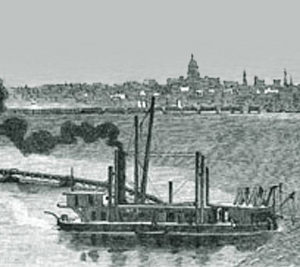‘Drain the Swamp’ Gave Us Cherry Trees
Donald Trump rode a populist wave to the White House promising to “drain the swamp” in Washington. Politicians have used the phrase for decades. Famously, President Ronald Reagan made it a catchphrase of his vow to reduce the federal bureaucracy.
The “swamp” really did exist in Eliza Scidmore‘s day. Literally — but not quite.
Many low-lying areas of the city were prone to flooding from the Potomac River and local streams. Not truly swamps, but swampy. One area, in particular, caused perennial complaints: the grounds west and south of the Washington Monument.
The monument stood near the banks of the Potomac, and the river’s tidal wetlands left the ground marshy much of the time. Officially, the area was known as the Potomac flats. Residents and the press derided the area as a “pestilential swamp.”
The photograph below shows the Potomac Flats as the area looked in 1863. The Washington Monument stood as a stump for almost 40 years, unfinished until 1884.

(Photo by Titan Peale; U. of Rochester Rare Books Collection)
Washington Canal Run-Off
The Washington City Canal aggravated the “swamp” problem of the Potomac Flats. The canal, which linked to Tiber Creek, ran parallel to the northern edge of the National Mall. (See photo below.)
The canal had been built as a commercial waterway to carry goods into the city. But it silted up over the decades and fell into disuse. In time, it functioned as a ditch collecting foul waste—sewage, rotting produce from market stalls on Pennsylvania Avenue, carcasses of dead animals.
When the canal and creek overran their banks during flooding, the refuse spilled onto the Potomac Flats. Most Washingtonians avoided that smelly part of the town. In hot weather the stink could get so bad it made life miserable for residents in and around the White House.
During a blitz of city improvements in the early 1870s, Alexander “Boss” Shepherd and his cronies paved over the canal. Today it’s Constitution Avenue.
The photo below, taken in 1860, shows the unsightly Washington Canal. The new dome of the Capitol was installed during the Civil War.

(Photo by Matthew Brady Studio; Library of Congress)
Flats Reclamation
As a longtime Washington resident, Eliza Scidmore followed the efforts to clean up the flats and fill in the land. The work began in the 1880s and continued beyond the turn of the century.
The Army Corps of Engineers decided to kill two birds with one stone by filling in the swampy flats with soil dredged from the Potomac River to deepen a channel.

Dredging in Potomac River 1891 (Source: Scientific American)
The filled-in land eventually gave the city more than 600 acres of land for public use. The reclaimed area extended the National Mall by a mile west of the Washington Monument. Today, the Lincoln Memorial occupies the spot at the far end.
The project also created the four-leaf clover-shaped reservoir we know as the Tidal Basin. It was designed with sluice gates to regulate the flow of fresh water between the Potomac and the Washington Channel. The Jefferson Memorial now stands on an island at one end of the Tidal Basin.
And of course, hundreds of the city’s now-famous Japanese cherry trees surround the Tidal Basin.
Eliza Scidmore — bent on beautifying a corner of the new Potomac Park — imported the idea for the cherry trees from Japan after she began traveling there in the 1880s.